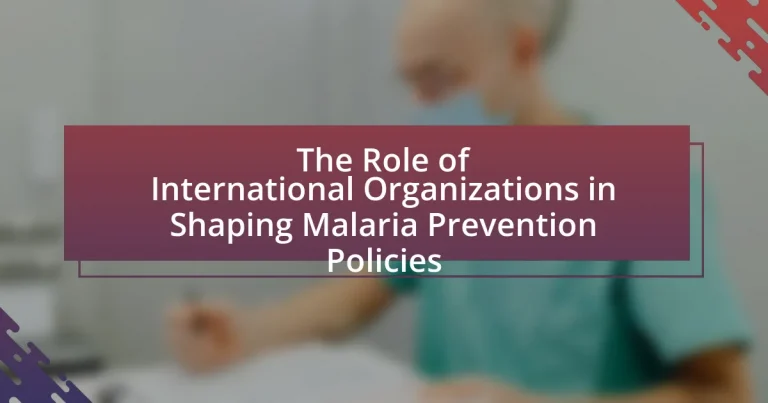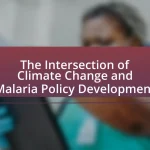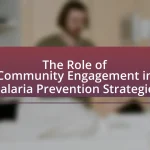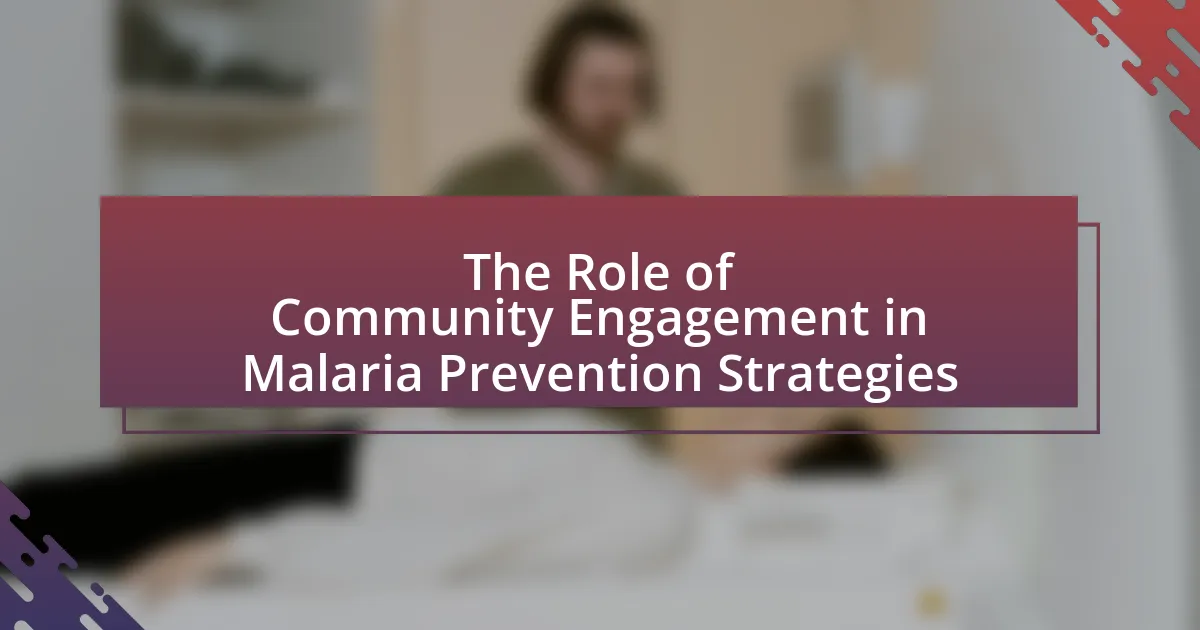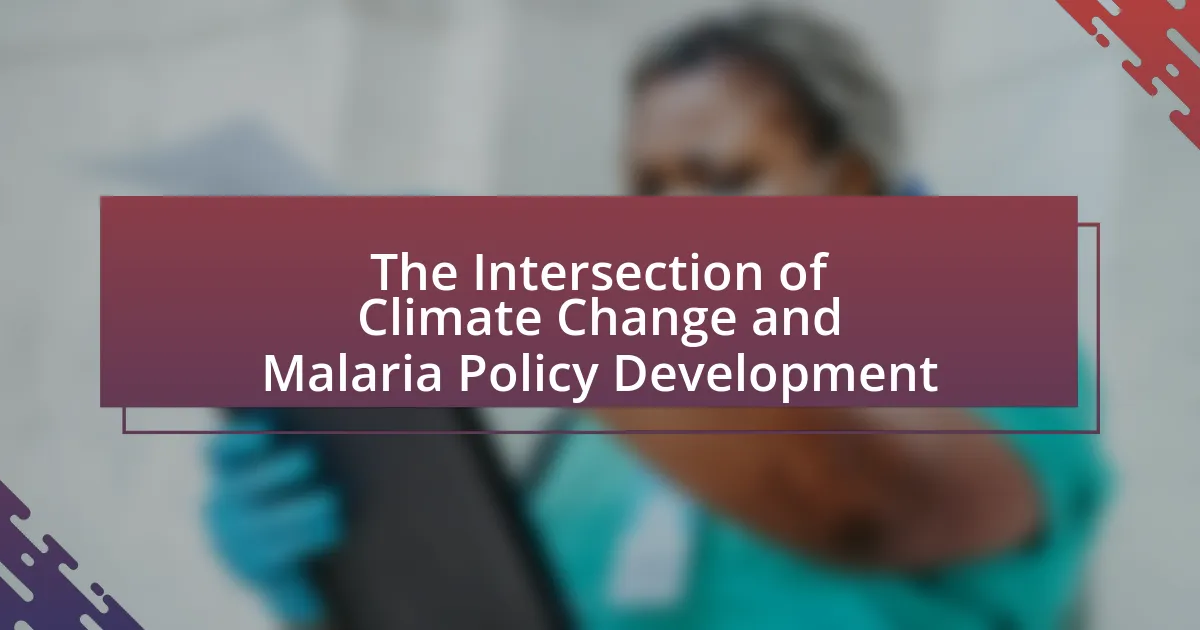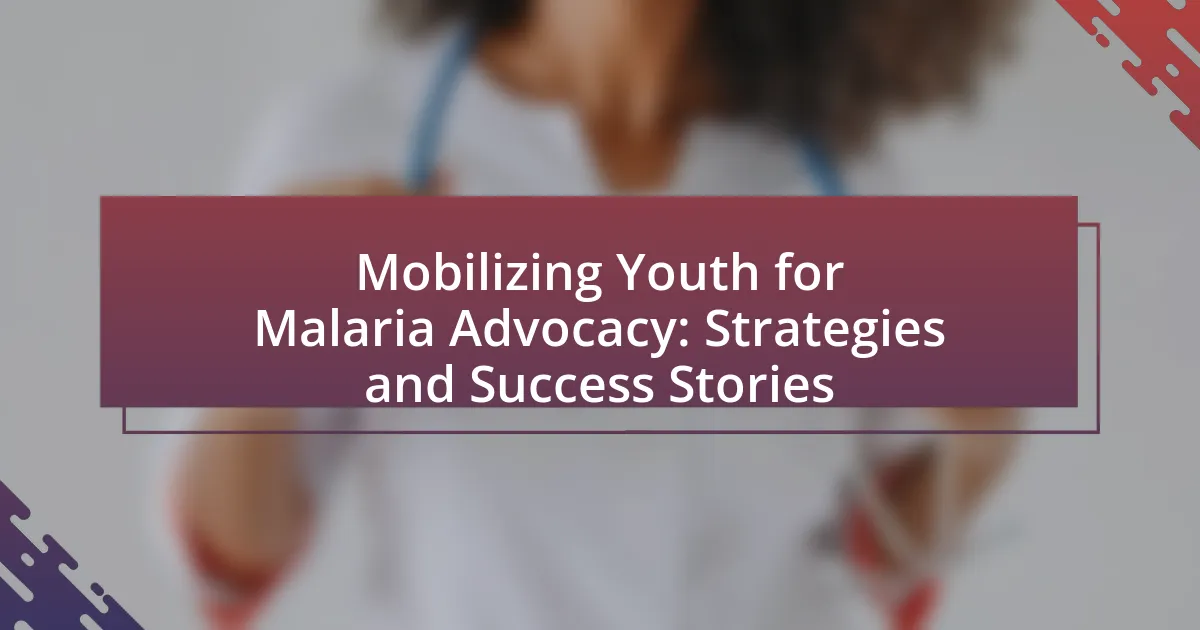International organizations, such as the World Health Organization (WHO) and the Global Fund to Fight AIDS, Tuberculosis and Malaria, play a pivotal role in shaping malaria prevention policies through funding, technical expertise, and collaborative platforms. They influence national strategies by providing guidelines, resources, and facilitating partnerships that enhance local capacities to combat malaria. The article examines the impact of these organizations on malaria prevention, the challenges faced by countries without international support, and the strategies employed to address socio-economic factors related to malaria. It also highlights the importance of research, public-private partnerships, and the outcomes of international involvement in reducing malaria incidence and mortality rates globally.
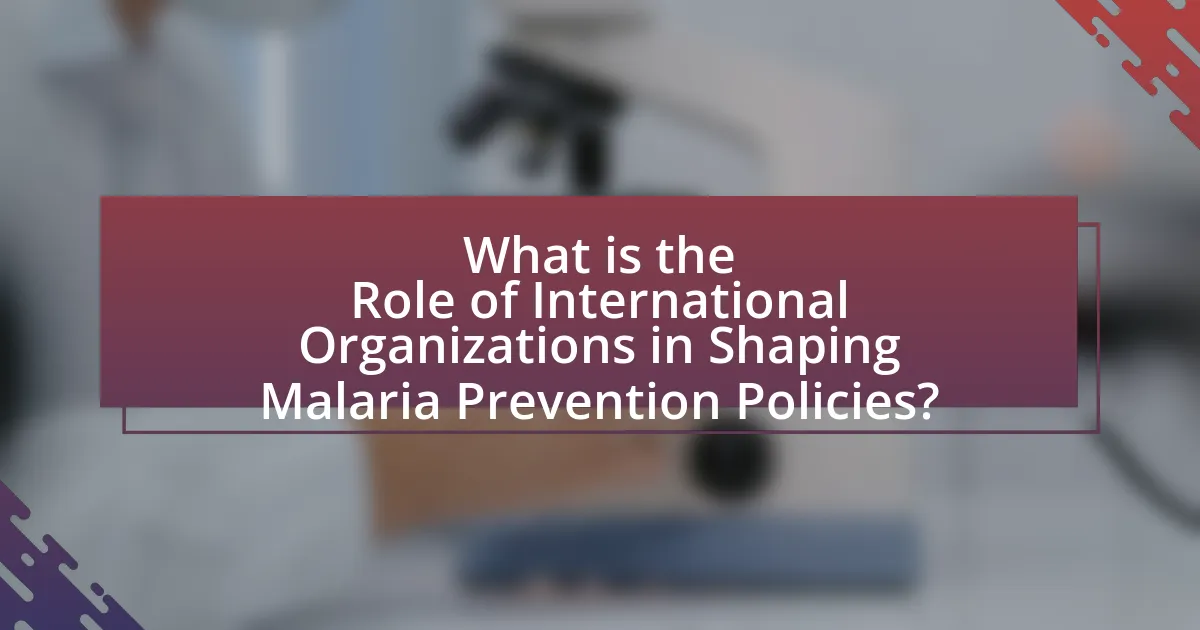
What is the Role of International Organizations in Shaping Malaria Prevention Policies?
International organizations play a crucial role in shaping malaria prevention policies by providing funding, technical expertise, and a platform for collaboration among countries. For instance, the World Health Organization (WHO) sets global health standards and guidelines, which influence national policies on malaria prevention. Additionally, organizations like the Global Fund to Fight AIDS, Tuberculosis and Malaria allocate significant resources to support malaria control programs in endemic countries, facilitating access to preventive measures such as insecticide-treated nets and antimalarial medications. Furthermore, international organizations foster partnerships and knowledge sharing, enabling countries to adopt best practices and innovative strategies in malaria prevention, as evidenced by the Roll Back Malaria Partnership, which has mobilized efforts across multiple sectors to reduce malaria incidence globally.
How do international organizations influence malaria prevention strategies?
International organizations influence malaria prevention strategies by providing funding, technical expertise, and policy frameworks that guide national efforts. For instance, the World Health Organization (WHO) sets global malaria control guidelines and provides resources for countries to implement effective interventions, such as insecticide-treated nets and antimalarial medications. Additionally, organizations like the Global Fund to Fight AIDS, Tuberculosis and Malaria allocate significant financial resources, totaling over $4 billion for malaria programs in 2020 alone, enabling countries to enhance their prevention and treatment efforts. These organizations also facilitate collaboration among nations, fostering knowledge sharing and best practices that strengthen local capacities to combat malaria effectively.
What are the key international organizations involved in malaria prevention?
The key international organizations involved in malaria prevention are the World Health Organization (WHO), the Global Fund to Fight AIDS, Tuberculosis and Malaria, and the United Nations Children’s Fund (UNICEF). The WHO leads global efforts to control malaria through guidelines, research, and funding initiatives, aiming to reduce malaria cases and deaths significantly. The Global Fund provides financial resources to countries for malaria prevention and treatment programs, supporting initiatives like insecticide-treated nets and antimalarial medications. UNICEF focuses on child health and nutrition, implementing malaria prevention strategies, particularly in vulnerable populations, to reduce child mortality associated with the disease.
How do these organizations collaborate with local governments?
International organizations collaborate with local governments by providing technical assistance, funding, and policy guidance to enhance malaria prevention efforts. For instance, organizations like the World Health Organization (WHO) and the Global Fund work closely with local health authorities to implement evidence-based strategies, such as insecticide-treated nets and indoor residual spraying, which have been shown to significantly reduce malaria transmission rates. Additionally, these organizations often facilitate training programs for local health workers, ensuring that they are equipped with the latest knowledge and skills to combat malaria effectively. This collaboration is supported by data indicating that countries receiving international support have seen a marked decrease in malaria cases, demonstrating the effectiveness of such partnerships in public health initiatives.
Why is the involvement of international organizations crucial in malaria prevention?
The involvement of international organizations is crucial in malaria prevention because they provide essential funding, expertise, and coordination among countries. Organizations like the World Health Organization (WHO) and the Global Fund mobilize resources and implement evidence-based strategies, which are vital for effective malaria control. For instance, the WHO’s Global Technical Strategy for Malaria 2016-2030 aims to reduce malaria incidence and mortality rates by at least 90% by 2030, demonstrating the impact of coordinated international efforts. Additionally, international organizations facilitate research and development of new tools, such as vaccines and treatments, which are critical for combating malaria effectively.
What challenges do countries face in malaria prevention without international support?
Countries face significant challenges in malaria prevention without international support, including limited financial resources, inadequate healthcare infrastructure, and insufficient access to effective treatments and preventive measures. For instance, many low-income countries rely on external funding to purchase insecticide-treated bed nets and antimalarial drugs; without this support, they struggle to maintain adequate supplies. Additionally, the lack of technical expertise and training for healthcare workers hampers effective disease management and response. According to the World Health Organization, countries with weak health systems are more vulnerable to malaria outbreaks, highlighting the critical role of international assistance in strengthening local capacities and ensuring sustainable malaria control efforts.
How do international organizations enhance resource allocation for malaria control?
International organizations enhance resource allocation for malaria control by mobilizing funding, coordinating global efforts, and providing technical assistance. For instance, the Global Fund to Fight AIDS, Tuberculosis and Malaria has invested over $4 billion in malaria programs since its inception, significantly increasing financial resources for prevention and treatment. Additionally, organizations like the World Health Organization facilitate partnerships among countries and stakeholders, ensuring efficient distribution of resources and best practices. These coordinated efforts lead to improved access to insecticide-treated nets and antimalarial medications, ultimately reducing malaria incidence and mortality rates.
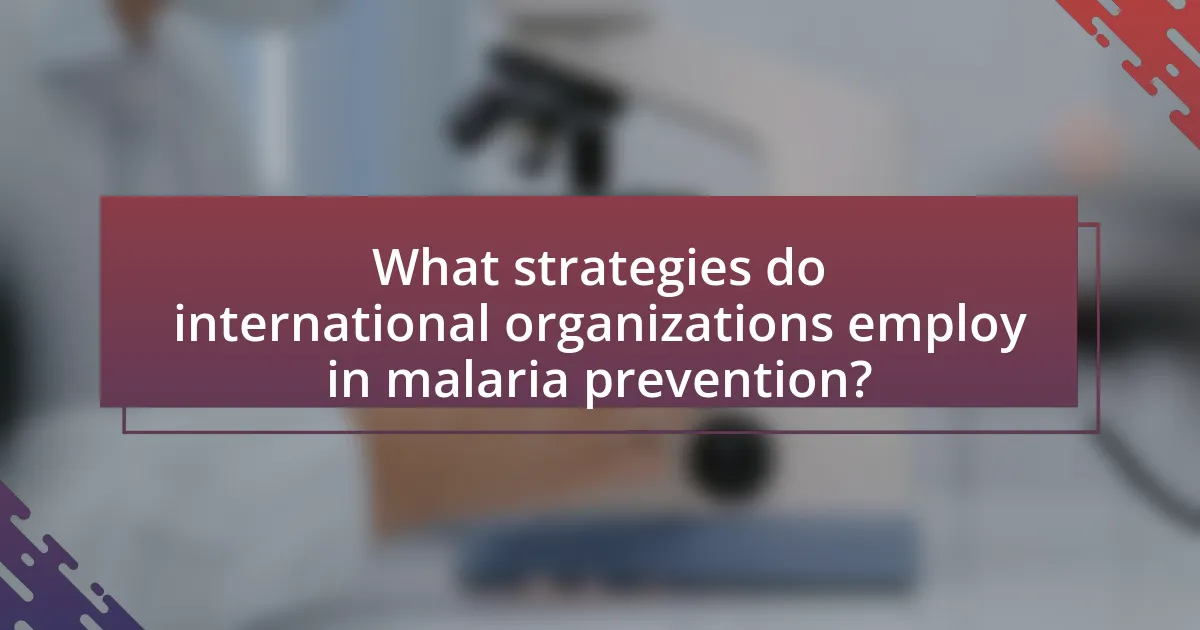
What strategies do international organizations employ in malaria prevention?
International organizations employ several strategies in malaria prevention, including the distribution of insecticide-treated bed nets, indoor residual spraying, and the promotion of rapid diagnostic tests and effective antimalarial treatments. For instance, the World Health Organization (WHO) recommends the use of long-lasting insecticide-treated nets, which have been shown to reduce malaria transmission by up to 50% in endemic areas. Additionally, organizations like the Global Fund support funding for malaria control programs that include vector control measures and community education initiatives. These strategies are backed by data indicating that comprehensive malaria prevention efforts can significantly lower incidence rates, as seen in countries like Rwanda, where malaria cases dropped by 60% between 2005 and 2015 due to such interventions.
How do these organizations develop and implement malaria prevention policies?
International organizations develop and implement malaria prevention policies through a systematic approach that includes research, collaboration, and evidence-based strategies. These organizations, such as the World Health Organization (WHO) and the Global Fund, conduct extensive research to identify effective interventions, such as insecticide-treated nets and antimalarial medications. They collaborate with governments, NGOs, and local communities to tailor these interventions to specific regional needs, ensuring cultural and logistical appropriateness. Furthermore, they utilize data from epidemiological studies and health metrics to guide policy formulation and implementation, demonstrating the effectiveness of their strategies in reducing malaria incidence. For instance, WHO’s Global Technical Strategy for Malaria 2016-2030 outlines specific goals and actions based on comprehensive data analysis, showcasing a structured method for policy development and implementation.
What role does research play in shaping these policies?
Research plays a critical role in shaping malaria prevention policies by providing evidence-based data that informs decision-making. For instance, studies conducted by the World Health Organization (WHO) have identified effective interventions, such as insecticide-treated nets and indoor residual spraying, which have been pivotal in reducing malaria transmission rates. Additionally, research findings on the efficacy of various antimalarial drugs guide treatment protocols and policy recommendations. The systematic review published in “The Lancet Infectious Diseases” highlights the importance of continuous research in adapting policies to emerging resistance patterns, ensuring that strategies remain effective against evolving malaria threats.
How do international organizations address the socio-economic factors of malaria?
International organizations address the socio-economic factors of malaria by implementing comprehensive strategies that focus on improving health systems, enhancing education, and promoting economic development in affected regions. For instance, the World Health Organization (WHO) collaborates with countries to strengthen healthcare infrastructure, ensuring access to malaria prevention tools such as insecticide-treated nets and antimalarial medications. Additionally, organizations like the Global Fund invest in community health programs that educate populations about malaria transmission and prevention, which is crucial in areas with high poverty rates where malaria is endemic. Evidence shows that these interventions lead to reduced malaria incidence and mortality, as seen in countries like Rwanda, where targeted funding and support have significantly decreased malaria cases since 2005.
What partnerships are formed to combat malaria effectively?
Partnerships formed to combat malaria effectively include collaborations between international organizations such as the World Health Organization (WHO), the Global Fund to Fight AIDS, Tuberculosis and Malaria, and the Roll Back Malaria Partnership. These organizations work together to implement strategies for malaria prevention, treatment, and research. For instance, the Global Fund has invested over $4 billion in malaria programs since its inception, significantly contributing to the reduction of malaria cases and deaths in various regions. Additionally, partnerships with local governments and non-governmental organizations enhance the reach and effectiveness of malaria interventions, ensuring that resources are allocated efficiently and tailored to specific community needs.
How do public-private partnerships contribute to malaria prevention efforts?
Public-private partnerships significantly enhance malaria prevention efforts by leveraging resources, expertise, and innovation from both sectors. These collaborations facilitate the development and distribution of effective malaria interventions, such as insecticide-treated bed nets and rapid diagnostic tests. For instance, the Global Fund to Fight AIDS, Tuberculosis and Malaria has mobilized over $4 billion for malaria programs through partnerships with private companies, which has led to a substantial increase in the availability of preventive measures in endemic regions. Additionally, these partnerships often enable the sharing of data and best practices, improving the overall effectiveness of malaria control strategies.
What role do non-governmental organizations play alongside international bodies?
Non-governmental organizations (NGOs) play a crucial role alongside international bodies in shaping malaria prevention policies by providing on-the-ground expertise, advocacy, and funding. NGOs often implement community-based programs that directly address malaria prevention, such as distributing insecticide-treated bed nets and conducting health education campaigns. For instance, organizations like Médecins Sans Frontières and the Global Fund collaborate with entities like the World Health Organization to enhance the effectiveness of malaria interventions. Their localized knowledge and ability to mobilize communities enable them to complement the broader strategies set by international bodies, ensuring that policies are adapted to specific regional needs and challenges. This partnership enhances the overall impact of malaria prevention efforts globally.
What are the outcomes of international organizations’ involvement in malaria prevention?
International organizations’ involvement in malaria prevention has led to significant reductions in malaria incidence and mortality rates globally. For instance, the World Health Organization reported a 29% decrease in malaria mortality rates between 2010 and 2019, largely attributed to the efforts of international organizations in distributing insecticide-treated nets, promoting rapid diagnostic tests, and facilitating access to effective antimalarial treatments. Additionally, initiatives like the Global Fund to Fight AIDS, Tuberculosis and Malaria have mobilized over $4 billion for malaria programs, enhancing surveillance and response strategies in endemic regions. These outcomes demonstrate the critical role that international organizations play in shaping effective malaria prevention policies and improving health outcomes in affected populations.
How effective have international organizations been in reducing malaria cases?
International organizations have been highly effective in reducing malaria cases globally. For instance, the World Health Organization (WHO) reported a 29% decline in malaria cases between 2010 and 2019, attributing this success to coordinated efforts in prevention, treatment, and education. Additionally, initiatives like the Global Fund to Fight AIDS, Tuberculosis and Malaria have invested over $4 billion in malaria programs, leading to significant reductions in mortality rates and increased access to preventive measures such as insecticide-treated nets and antimalarial medications. These organizations have played a crucial role in mobilizing resources, implementing strategies, and fostering international collaboration, which has been essential in combating malaria effectively.
What metrics are used to measure the success of malaria prevention initiatives?
The success of malaria prevention initiatives is measured using several key metrics, including the reduction in malaria incidence rates, the decrease in malaria mortality rates, and the coverage of preventive measures such as insecticide-treated nets (ITNs) and indoor residual spraying (IRS). For instance, the World Health Organization (WHO) reports that countries achieving a significant decline in malaria cases often show a correlation with increased ITN usage, which can be quantified through household surveys. Additionally, the effectiveness of these initiatives is evaluated through the monitoring of parasite prevalence in specific populations, as well as the accessibility and utilization of antimalarial treatments. These metrics provide concrete evidence of the impact of malaria prevention strategies and guide future policy decisions.
How do success stories from different regions inform future policies?
Success stories from different regions inform future policies by providing evidence-based models that demonstrate effective strategies in malaria prevention. For instance, the successful implementation of the Roll Back Malaria initiative in sub-Saharan Africa has led to a significant reduction in malaria cases, showcasing the impact of coordinated efforts in vector control and community engagement. This data-driven approach allows policymakers to replicate successful interventions, adapt them to local contexts, and allocate resources more effectively. Furthermore, the World Health Organization’s documentation of these successes serves as a reference point for best practices, guiding future policy development and implementation in various regions facing similar challenges.
What lessons can be learned from the experiences of international organizations in malaria prevention?
International organizations have demonstrated that coordinated efforts and funding are crucial for effective malaria prevention. For instance, the Global Fund to Fight AIDS, Tuberculosis and Malaria has mobilized over $4 billion for malaria programs, significantly reducing malaria cases in countries like Zambia and Uganda. Additionally, the World Health Organization’s guidelines emphasize the importance of integrated vector management and community engagement, which have proven effective in various regions. These experiences highlight the necessity of collaboration among governments, NGOs, and local communities to achieve sustainable malaria control and prevention strategies.
What best practices can be adopted for future malaria prevention efforts?
Effective best practices for future malaria prevention efforts include the integration of vector control strategies, community engagement, and the use of innovative technologies. Vector control, such as the distribution of insecticide-treated bed nets and indoor residual spraying, has been shown to significantly reduce malaria transmission rates, as evidenced by a 50% decrease in cases in regions implementing these measures. Community engagement ensures that local populations are informed and involved in prevention efforts, which enhances compliance and sustainability; studies indicate that community-driven initiatives can lead to a 30% increase in the use of preventive measures. Additionally, leveraging innovative technologies, such as mobile health applications for tracking and reporting malaria cases, can improve surveillance and response times, as demonstrated by successful implementations in countries like Kenya and Ghana. These practices, supported by data and successful case studies, form a comprehensive approach to malaria prevention.
What practical steps can countries take to enhance collaboration with international organizations?
Countries can enhance collaboration with international organizations by establishing formal partnerships, sharing data, and participating in joint initiatives. Formal partnerships, such as agreements or memorandums of understanding, create a framework for cooperation and resource sharing. Sharing data on malaria prevalence, treatment efficacy, and prevention strategies allows for informed decision-making and targeted interventions. Participating in joint initiatives, like global health campaigns or research projects, fosters a collaborative environment that leverages the strengths of both countries and organizations. For instance, the World Health Organization’s Global Malaria Programme has successfully coordinated efforts among member states to reduce malaria incidence through shared resources and strategies.
